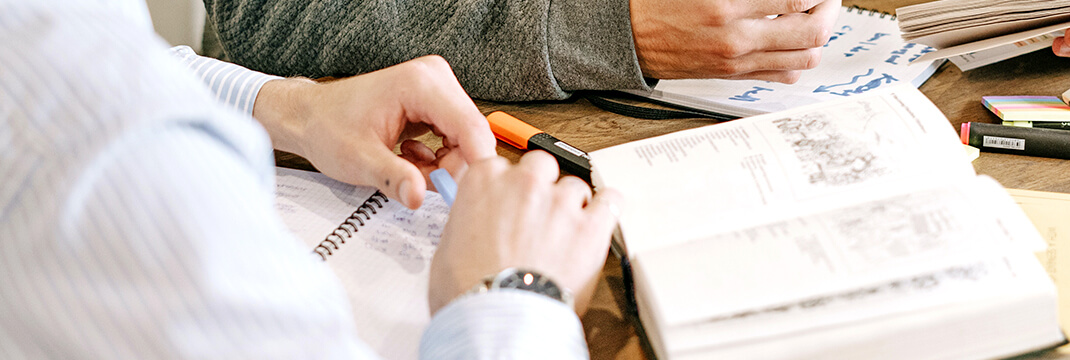
Before learning the principles of punctuation, it is first and foremost important to know what each punctuation mark looks like. In this article, you will find guidelines on the usage of semicolons, colons, and dashes. Read on to find out cases when to use each of these punctuation marks.
Semicolons
A semicolon looks like a comma with a full stop above it (;). Visualizing a comma with a full stop somewhere in the air above it is a good way to remember how it is written. A semicolon is something in-between a comma and a full stop. It creates less separation between sentences, parts of the sentence or logical units within a sentence than a full stop but more separation than a comma. A semicolon has two main cases of usage:
1. It is placed to separate items within a list, especially if the items already contain commas. This usage in a list differs from the possible usage in a sentence. For example, imagine that you have bought four items in a shop:
Grapes
Peaches
Melons
Pears
If you make up a sentence about what you have bought, it would look like this:
I have bought grapes, peaches, melons, and pears.
As such, if you enlist some items in a sentence, you normally use commas between them.
However, if you add more description for each of the items (in the form of adjectives), the sentence can be rather confusing. Just have a look:
I have bought shiny grapes, juicy, sweet peaches, ripe, delicious melons, and firm, shiny pears.
The middle of the sentence, in particular, looks confusing. Therefore, it would be better to rewrite it this way by using semicolons:
I have bought shiny grapes; juicy, sweet peaches; ripe, delicious melons; and firm, shiny pears.
To avoid too many commas within a sentence, you should use semicolons to separate logical units.
2. When you want to join two sentences. A semicolon is usually used to separate two independent clauses. The main difference between a full stop and a semicolon, in this case, is that the latter pinpoints that the items are related and that two independent clauses are not finished but are logically united. All of the clauses separated by a semicolon may refer to one and the same topic. For example, I went to the supermarket yesterday. I bought different fruits; melons, watermelons, grapes, pears, and apples were on sale.
If you use a full stop after each of the clauses, the sentences would seem short and abrupt.
Invite your friends and get bonus from each order they
have made!
Colons
Colons are used after independent clauses (it means they can be used, as separate sentences alone – each of them is a completed logical unit). A colon usually precedes an explanation or a surprising fact (as a means of drawing attention to something). Besides, it is used for joining ideas together.
The most widespread usage of colons:
-
To draw attention to a specific fact/ idea/ phrase/ aspect/ problem, etc.
-
Before a list. For example, We bought a lot of fruits in the supermarket: pears, apples, melons, peaches, and others.
-
Before nouns and noun phrases. For instance, My family gave me everything I needed most: love, support, and compassion.
-
Before direct quotes. For example, Rene Descartes said: “I think, therefore I am.”
-
To join two sentences, where the second one explains, sharpens or summarizes the first one.
-
In time phrases (numerical): 02:45:00 (2 – for hour; 45 – for minutes; 00 – for seconds).
-
In titles, particularly in Biblical verses: 2:1, Matthew 2:25, etc.
Common Mistakes in Usage of a Colon
-
When one uses a colon between a verb and a complement (or an object). Wrong sentence: The best fruit are: those that are grown in warm countries. To correct this sentence, simply remove the colon.
-
When one puts a colon between a preposition and an object.
Wrong sentence: My favorite dish is made of pasta, pesto, cheese, and sour cream. To correct the sentence, simply remove the colon. -
When one puts a colon after “including,” “such as,” especially, and other similar phrases. This is the violation of the rule that a colon is used between two independent and logically complete phrases. Since you cannot finish a sentence with “including” or “such as,” it is wrong to put a colon after such phrases.
How to Spot Mistakes?
If you hesitate whether you should place a colon after a specific phrase or not, ask yourself a question whether the part of the sentence can be used on its own. Will, that part of the sentence form a complete phrase?
If you wonder whether you should capitalize on the very first word after the colon, follow specific requirements. Such rules depend on the citation style. For example, APA, MLA, ASA, AMA, and Chicago have different rules about the usage of a colon. All in all, whatever means of writing you use (whether you capitalize or not), be consistent throughout the paper.
Dashes
The most important thing you should be aware of when it comes to using dashes is that they are never required by some specific punctuation or grammar rules. Still, make sure you do not exceed the usage of dashes since plenty of dashes will make the paper hard to read and confusing. An excessive number of dashes can make your writing choppy.
It is essential to differentiate between hyphens and dashes. Hyphens are shorter and they are used in compound words to show connections between them. As a rule, such complexes of words are used as a single unit: well-versed, easy-going, etc. Besides, the usage of hyphens is also required in specific words, such as e-mail.
Check out the following cases, when dashes are used in sentences:
1. To highlight material or information that needs to be emphasized. To understand this rule, think of dashes as a complete antonym to parentheses. While parentheses are used for some extra information that is not always worth mentioning, dashes are used to introduce some important facts. As a rule, this important material is placed between two dashes. When you use a single dash, you highlight the information written at the end of the sentence or its beginning. For example, After many years of living in a dream, the old man decided to visit the place of his dreams – Switzerland. “The Black Mirror” – an exciting television program or a depressive program for many youths and adolescents?
2. Two dashes emphasize the information or facts presented in the middle of a sentence. According to some grammar guidelines, one may even place a whole sentence between the dashes. Have a look: Everything I saw in my new city – from the majestic green trees to the impressively constructed architecture – reminded me of my university. The boys – they were each of 8-10 years of age – gathered together to play football in the playground.
Apart from these cases, two dashes pinpoint to a modifier. If you want to highlight the words or phrases that relate to the noun description, you can set them off with two dashes on each side. Take a look at the following examples: The playgrounds – wet and dirty in the November rain – were deserted. My dog – with a nose help high – appeared from the forest.<
3. To underline the introduction or conclusion of the sentence. In other words, a dash is used as an indicator that specific words are separated as introductory or conclusive ones. For example, Pens, paper, books, pencils – many students from Africa lacked even these basic tools for learning. To improve the general state of well-being and health, people need to carefully examine the food they consume each day – sugars, snacks, junk food, fast food, etc.
4. To highlight additional (extra) phrases, which add some information or details but are not necessary for the comprehension of the general idea. As a rule, such parts of the sentence are separated with commas, but if there are a lot of commas in such a sentence, then it is better to set the sentence off with a dash. It will help readers understand the sentence better and delve deeper into the structural elements. For example, Even the simplest routine chores – dressing, washing, cooking, and cleaning – became next to impossible when she broke her leg.
5. To break up a written dialogue. What to do if you need to write dialogue and mark the point where the speaker makes an abrupt stop or stops speaking? Or when one speaker is interrupted by another speaker? In such cases or in cases when you want to highlight one’s stuttering, use a dash: I – I do not know what he was saying. She started to explain herself straightaway, saying, “I was thinking about – About –.” “I do not care what you were thinking about,” Ronald interrupted.
Struggling with your essay?
Ask professionals to help you!
Start Chat
Hopefully, our brief but comprehensive guide on punctuation will help you decide when to use colons, semicolons, and dashes best. Read the article attentively and enrich your knowledge in academic writing.



